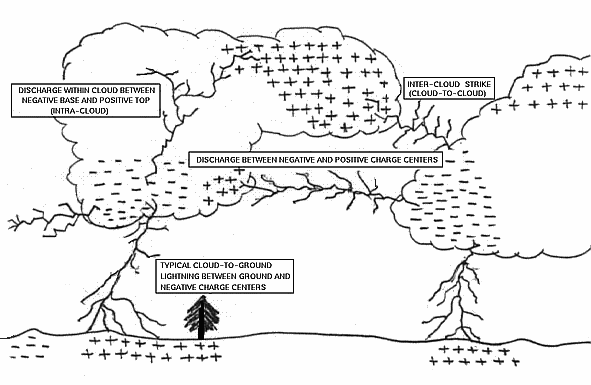
Have you ever wondered how lightning and thunder work?

What is lightning?
Lightning is a bright flash of electricity produced by a thunderstorm. All thunderstorms produce lightning and are very dangerous. If you hear the sound of thunder, then you are in danger from lightning.
What causes lightning?
Lightning is an electric current. Within a thundercloud way up in the sky, many small bits of ice (frozen raindrops) bump into each other as they move around in the air. All of those collisions create an electric charge. After a while, the whole cloud fills up with electrical charges. The positive charges or protons form at the top of the cloud and the negative charges or electrons form at the bottom of the cloud. Since opposites attract, that causes a positive charge to build up on the ground beneath the cloud. The grounds electrical charge concentrates around anything that sticks up, such as mountains, people, or single trees. The charge coming up from these points eventually connects with a charge reaching down from the clouds and - zap - lightning strikes!

How hot is lightning?
The temperature at the surface of the sun is about 5600 °C. Lightning is 6 times hotter than the surface of the sun!
What causes thunder?
Any sound you hear is made up of vibrations. The vibrations travel as a sound wave through the air, until they reach your ear. Lightning is a huge discharge of electricity, and this electricity shoots through the air, causing vibrations to be formed in two ways:
1. The electricity passes through the air and causes air particles to vibrate. The vibrations are heard as sound.
2. The lightning is also very hot and heats up the air around it. Hot air expands, and in this case the air expands very quickly, pushing apart the air particles with force and creating more vibrations.
This is what we hear and call thunder – the rumbling of thunder is simply caused by the vibration or sound of the air affected by lightning. If you’re nearby to a lightning strike, you may have heard thunder as a really loud crack, almost like the sound of a whip being cracked. But, most of the time we hear thunder as a loud, long rumble.
In fact, the crack sound is the direct sound of the lightning near us, reaching our ears. The more common rumbling effect happens when thunder echoes off objects all around us. This happens a lot in towns and cities, where there are lots of buildings for the noise to bounce off. However even in flat areas of land, with no trees or other objects, there is quite often a rumble as the thunder simply bounces off the ground on its way to our ears. All this echoing transforms the original ‘crack’ sound into a longer ‘rumble’!
How far can you see lightning and hear thunder?
Within those distant thunderstorms, the lightning bolts can be seen as much as 160m from us, depending on the height of the bolt, the clarity of the air, and our elevation. Thunder, in comparison, has a much shorter range of detection - usually less than 8m in a noisy city environment.